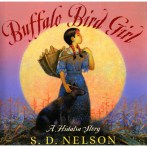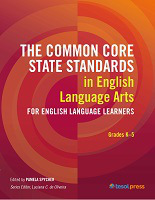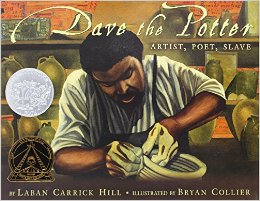Picture Books to Help ELLs Access Common Core Anchor Reading Standards
 In this blog post written for Colorín Colorado, ELL expert Judith O'Loughlin shares some strategies for using picture books across the curriculum with students of all ages in order to master the Common Core anchor reading standards.
In this blog post written for Colorín Colorado, ELL expert Judith O'Loughlin shares some strategies for using picture books across the curriculum with students of all ages in order to master the Common Core anchor reading standards.
Whether you live in California and identify beginning ELLs as "emerging," or are from a WIDA state and identify these same students as "entering," the challenge of meeting the Common Core Anchor Reading Standards is the same. It's a daunting task to teach ELLs at this entry level as they grapple with complex text and struggle to meet the standards, as evidenced California's English Language Development Standards principle "Interacting in Meaningful Ways." Because the standards focus on reading and interacting with complex text as well as addressing the importance of interaction, collaboration, comprehension, and communication of ideas, ELLs need substantial support to meet these challenges. Picture books can help!
This blog post describes how picture books can provide ELLs access to the Common Core Anchor Reading Standards, provides suggestions for books that meet certain standards and also meet the defined skill(s) for understanding those standards, and offers a checklist for choosing picture books along with a sample lesson plan on using picture books with ELLs.
Why Picture Books?
I love picture books! Anyone who knows me knows how much I love picture books. I've used picture books in teacher training and various conference presentations to introduce topics related to the content reading challenges English language learners (ELLs) face in U.S. schools, or to explore culture and culture clashes through the lens of the second language learner. When I taught K-8 ESL in New Jersey, I focused on teaching thematically across content areas and used numerous picture books to introduce and develop concepts in topics such as Civil Rights, war, and key time periods in history, as well as to explore space, the ocean, land formations, and other earth science topics. I've even used picture books to explore mathematics concepts and health topics, such as nutrition and body battles with germs!
Although in the past picture books were used primarily by early elementary grade teachers in oral whole class readings to introduce story elements, today more and more picture books are being produced and are being used in upper elementary, middle, and even high schools to enhance instruction in social studies, science, and mathematics. To support the use of picture books in various learning contexts several published articles, such as "A New Age for Picture Books" and a few professional guides, such as The Power of Picture Books: Using Content Area Literature in Middle School, have supported the use of picture books for academic instruction with mainstream middle and high school students.
Picture Books and the Common Core Anchor Reading Standards
Recently, I've been looking at picture books through a new lens – addressing the Common Core State Standards, specifically the Anchor Reading Standards. I have focused on each anchor standard with a variety of content topics that could be used to teach ELLs using picture books.
When I started exploring how picture books could provide substantial support toward meeting the CC Anchor Reading Standards, I carefully analyzed the criteria in each of the Anchor Reading Standards: Key Ideas and Details, Craft and Structure, Integration of Knowledge and Ideas, and Range of Reading and Levels of Text Complexity. Through close reading and an analysis of what each anchor standard required, I was able to create a list of sample picture books that would provide a jumping off point to explore the standards.
Matching Picture Books to Content Topics and Anchor Standard
When reviewing these books to help ELLs meet the CCSS, I asked myself, "Were there picture books that would not only match a CC Anchor Reading Standard category but also provide instruction in a content topic, either as literary or informational text (or both)?" Additionally, it was important to consider the picture books needed to build necessary content background and align with the grade/subject curriculum. At first, I needed to determine if there were picture books that would meet the standard and also meet the defined skill(s) for understanding the standard. I have developed several sample lists for book choices. The table below is one example.
Sample Picture Book Choices and CCSS Anchor Reading Standards
| Standard in the Strand | Defined Understandings for the Standard | Picture Book Example |
|---|---|---|
| Key Ideas and Details | Close reading and inference | Painted Words, Aliki |
| Themes and supporting details | Shin's Tricycle, Tatsuhara Kodama | |
| How individuals, events and ideas develop | Baseball Saved Us, Ken Mochizuki | |
| Craft and Structure | Interpret words and phrases | Amelia and Eleanor Go For a Ride, Pam Muñoz Ryan |
| Analyze structure of text | Streets of Gold, Rosemary Wells | |
| Point of view or purpose | Passage to Freedom, Ken Mochizuki | |
| Integration of Knowledge and Ideas | Integrate and evaluate content: diverse media and formats | Through My Eyes, Ruby Bridge (With online resources, YouTube, video clips) |
| Delineate and evaluate argument | Faithful Elephants, Yukio Tsuchiya | |
| Analyze how two or more texts address similar themes or topics |
| |
| Range of Reading and Level of Text Complexity | Read and comprehend complex literary and informational text |
|
A Checklist of Criteria for Choosing Picture Books
 How do I determine the quality and accuracy of a picture book to not only address an anchor standard but also to provide substantial support for beginning ELLs? Here are a few things I look for in picture books for content studies presented as fiction, historical fiction, or non-fiction.
How do I determine the quality and accuracy of a picture book to not only address an anchor standard but also to provide substantial support for beginning ELLs? Here are a few things I look for in picture books for content studies presented as fiction, historical fiction, or non-fiction.
- Illustrations and content are free from stereotypes and caricature representations of characters, settings, and artifacts. For example, books about Native Americans may depict stereotypes or misinformation, such as the idea that all Native Americans live in tee-pees or wear feather headdresses. Others may imply that Native Americans are part of history rather than part of today's contemporary world, or focus only on one dimension of history. Buffalo Bird Girl by author S. D. Nelson (a member of the Standing Rock Sioux Tribe) is the biography of a young girl born in 1839 who was a member of the Hidatsa people living along the Missouri River on the Great Plains. The book includes information on her daily life, including her home, an earth-mound lodge. For recommendations on choosing culturally appropriate books, see the recommended resources from Colorín Colorado below.
- Text and illustrations support one another. There should be a correlation between drawings, words, sentences, and paragraphs in text. In Bunting's So Far From the Sea, the illustrations on each page support the story of a family returning to a California historic Japanese internment camp for the last time before moving East.
- Appropriate academic vocabulary is introduced for the topic, both visually and in print. For example, essential vocabulary and idiomatic expressions, (e.g. "bright idea") are illustrated in the pictures and used in sentences that provide sufficient context to help students understand the meaning. Sometimes the key vocabulary may be presented in a different font, color, or bold as in Johnson's Levi Strauss Gets a Bright Idea.
- Abstract concepts are supported through visuals and controlled language. Dialogue supports both images and content concepts. For example, in Neuschwander's Pastry School in Paris: An Adventure in Capacity the concepts of measurement (liquids and solids) and an understanding capacity are carefully explained through dialogue, visuals, and a recipe.
- In-depth approach to an aspect, if not the complete topic, by building background. For example, Mochizuki's Passage to Freedom: The Sugihara Story tells the true story of a Japanese diplomat stationed in Lithuania in 1940 who helped Jews escape the Nazis.
Lens on Instruction: Picture Book Content Lesson
 I've recently written chapters in two books in series about the Common Core where I incorporated picture books in each chapter's standards-based content lesson. In "Grade 3: What Time is It?" in Gottlieb & Ernst-Slavit's (Eds.) Academic Language in Diverse Classrooms, the lesson on elapsed time uses picture books such as Hutchens' Clocks and More Clocks to model visually, as well as in words, how to comprehend and calculate elapsed time (CCSS.Math.Content.3.MDA.1). In "Beyond History: Glimpses into the Past through Picture Books." in Spycher (Ed.), Common Core State Standards in English Language Arts for English Language Learners: Grades K-5, part of a new TESOL Series CCSS for ELLs, I focused on enhancing the topic "From Slavery to Civil Rights" with picture books. My book selections help bridge the topic from pre-Revolutionary times to school desegregation and the Civil Rights Movement.
I've recently written chapters in two books in series about the Common Core where I incorporated picture books in each chapter's standards-based content lesson. In "Grade 3: What Time is It?" in Gottlieb & Ernst-Slavit's (Eds.) Academic Language in Diverse Classrooms, the lesson on elapsed time uses picture books such as Hutchens' Clocks and More Clocks to model visually, as well as in words, how to comprehend and calculate elapsed time (CCSS.Math.Content.3.MDA.1). In "Beyond History: Glimpses into the Past through Picture Books." in Spycher (Ed.), Common Core State Standards in English Language Arts for English Language Learners: Grades K-5, part of a new TESOL Series CCSS for ELLs, I focused on enhancing the topic "From Slavery to Civil Rights" with picture books. My book selections help bridge the topic from pre-Revolutionary times to school desegregation and the Civil Rights Movement.
Sample Lesson Plan: Dave, The Potter: Artist, Poet, Slave
Here's an example of how to address an historical topic for ELLs with a picture book for a reading lesson.

Topic: Slavery (1800s)
Book: Dave, The Potter: Artist, Poet, Slave by Laban Carrick Hill
Standards: CCSS.ELA-Literacy CCRAR.1 Key Ideas and Details – evidence and inferences from the text; CCRAR.2 – summarize the central theme, support from key details and ideas.
Instructional Steps: This book is a biography focused on a slave who led an unusual life; he was a potter and he could read.
- Generate a list of things students already know about slaves on the left side of a T-chart. Students may know, for example, that slaves were owned by a master, worked hard in the fields or house, and in general could not read or write. (For additional ideas, see the related lesson plans on TeachingBooks.net and the History Channel's photo gallery on the daily lives of slaves.)
- Conduct a picture walk through the book. Ask and answer questions based on illustrations, which include steps in making a piece of pottery.
- During the picture walk with students,
- List information learned about Dave as a slave on the right side of the T-chart.
- Generate a list of vocabulary words based on students' picture observations and questions.
- Set the scene
- Show a map of the stoneware region of South Carolina where Dave lived. Connect to where other slaves lived and worked.
- Show pictures of potters' wheels and explain how they work.
- Review vocabulary generated during picture walk. Later, after first reading, add vocabulary presented in similes (e.g., "as fast as a carnival's wheel of fortune," "like a magician pulling a rabbit out of a hat," etc.). Clarify what these mean through drawings or pictures and help students connect concepts in the simile to creating pots/pottery.
- Read to students, asking questions about key ideas and details in the text.
- Reread, having students taking turns reading the pages (organize text in meaningful chunks for individual or choral readings). Depending on the English proficiency levels of the group, the rereading should be done 1-3 times, focusing on text details and a summary of events).
- Sequence – Have students explain the steps in making a pot, visually described in the pull-out pages. (CCRA – Key Ideas and Details – CCRA.R1)
- Symbolism – Focus on "Why is Dave both a slave and a free man? How do you know?" Use the pictures to determine the answer. (CCRA – Key Ideas and Details – CCRA. R1 and R2)
- Summarizing: Have students write 3-5 sentences summarizing what they learned.
- Differentiation: Sentence stems or frames; storyboard graphic organizer (3-5 frames) or a student writes a few words/phrases (copied from a vocabulary bank) or dictates responses to a classmate who scribes the response on a graphic organizer.
Conclusion
As you can see in the brief lesson summary above, a teacher can use picture books to facilitate students' comprehension of complex content concepts and aspects of historical concepts, learn content vocabulary, and understand simple similes and metaphors presented both in words and through visuals. With the visual and textual support provided in picture books, beginning ELLs can use higher-order thinking skills, learn concepts beyond their current language proficiency level, and approach, if not meet, the CCSS Anchor Reading Standards.
Resources from Colorín Colorado
- Themed Multicultural Booklists for Children & Young Adults
- Culturally Relevant Books in the ELL Classroom
- Tips for Choosing Culturally Appropriate Books & Resources About Native Americans
- Multicultural Publishers, Awards, and Resources
About the Author
 Judith B. O'Loughlin is an education consultant and teacher trainer, working with general education and ESL/bilingual teachers, school districts, and state departments on standards-based instruction and assessment, sheltered instructional lesson planning and implementation, and curriculum guidance projects. A veteran K-12 educator, Ms. O'Loughlin is the Past President of NJTESOL/NJBE and an e-list monitor for the Elementary Interest Section of TESOL.
Judith B. O'Loughlin is an education consultant and teacher trainer, working with general education and ESL/bilingual teachers, school districts, and state departments on standards-based instruction and assessment, sheltered instructional lesson planning and implementation, and curriculum guidance projects. A veteran K-12 educator, Ms. O'Loughlin is the Past President of NJTESOL/NJBE and an e-list monitor for the Elementary Interest Section of TESOL.
Ms. O'Loughlin has been extensively involved in the field of second language acquisition, as a frequent presenter at state, regional, and national conferences and has published articles in NABE News, CATESOL News, TESOL's Essential Teacher and TESOL Connections. Her service to the field includes serving on the boards of NJTESOL-NJBE, CATESOL, and service on several TESOL standing committees, including chairing the Professional Development Committee. She has also been an adjunct graduate professor for online and blended graduate courses for bilingual/ESL endorsement and M.Ed. programs in New Jersey and Missouri, and currently as an eCoach for a grant project for Ohio State University. She provides training on the WIDA ELP Standards, ACCESS for ELLs®, and the W-APT™.
References
Carrick Hill, L. (2010). Dave the potter: Artist, poet, slave. New York, NY: Little Brown and Co.
Fresch, M. J. & Harkins, P. (2009). The power of picture books: Using content area literature in middle school. Urbana, IL: National Council of Teachers of English.
Hutchens, P. (1994). Clocks and more clocks. New York, NY: Aladdin Paperbacks, Simon and Schuster Books for Young Readers.
O'Loughlin, J. (2014). Beyond history: Glimpses into the past through picture books. In P. Spycher (Ed.), Common core state standards in English language arts for English languages learners: Grades k-5. Alexandria, VA: TESOL Press.
O'Loughlin, J. (2013). Grade 3: What time is It?. In M. Gottlieb & G. Ernst-Slavit (Eds.), Academic language in diverse classrooms: Promoting content and language learning: Mathematics, grades 3-5. Thousand Oaks, CA: Corwin.
Testa McCann, G. (2007). A new age for picture books. NJEA Review, 81(4), 4-5.
Trelease, J. (2006). The read-aloud handbook (6th ed.). Toronto, Canada: Penguin Books.







Add new comment